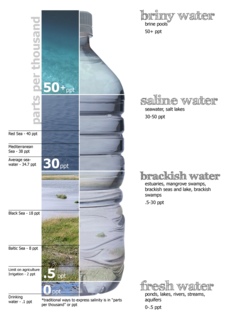| Part of a series on |
| Water salinity |
|---|
 |
| Salinity levels |
|
Fresh water (< 0.05%) Brackish water (0.05–3%) Saline water (3–5%) Brine (> 5% up to 26%–28% max) |
| Bodies of water |
Brine (or briny water) is water with a high-concentration solution of salt (typically sodium chloride or calcium chloride). In diverse contexts, brine may refer to the salt solutions ranging from about 3.5% (a typical concentration of seawater, on the lower end of that of solutions used for brining foods) up to about 26% (a typical saturated solution, depending on temperature). Brine forms naturally due to evaporation of ground saline water but it is also generated in the mining of sodium chloride.[1] Brine is used for food processing and cooking (pickling and brining), for de-icing of roads and other structures, and in a number of technological processes. It is also a by-product of many industrial processes, such as desalination, so it requires wastewater treatment for proper disposal or further utilization (fresh water recovery).[2]
- ^ Cite error: The named reference
Ullmannwas invoked but never defined (see the help page). - ^ Panagopoulos, Argyris; Haralambous, Katherine-Joanne; Loizidou, Maria (November 2019). "Desalination brine disposal methods and treatment technologies – A review". Science of the Total Environment. 693: 133545. Bibcode:2019ScTEn.693m3545P. doi:10.1016/j.scitotenv.2019.07.351. PMID 31374511. S2CID 199387639.